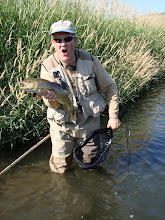Here is a post I made on the Washington Flyfishing board in response to a request to describe my favorite "secret place" among the 100 streams in Washington that I have caught fish in - not asking for a location, just a description. Here is what I posted.
As we all know, no place is really secret. But I'm sure we all have a happy place or two we return to again and again, both in mind and body. That place where your heart starts beating faster as you round the last bend or crest the hill and you sigh with relief when you see the empty pullout and know you'll have it all to yourself. Here is one of mine.
From the parking area, you look down onto a small stream in a desert canyon, sagebrush hills rising steeply on either side, the crystal clear water slipping over the rounded basalt and falling into deep pools. Upstream of these swimming holes, the little stream flows gently through the overhanging brush and that awful grass, whose leaning stems by summer's end almost touch at the midpoint of the stream, leaving a tiny strip of open water where you must carefully and accurately lay your fly. The scent of mock orange fills the canyon with a heavy sweetness in the stillness of the hot, summer evening. Approaching the first opening in the grass and brush, you look down through the clear water to the moss-covered rocks below. You don't see any fish, but you know they are there; they always are.
From the parking area, you look down onto a small stream in a desert canyon, sagebrush hills rising steeply on either side, the crystal clear water slipping over the rounded basalt and falling into deep pools. Upstream of these swimming holes, the little stream flows gently through the overhanging brush and that awful grass, whose leaning stems by summer's end almost touch at the midpoint of the stream, leaving a tiny strip of open water where you must carefully and accurately lay your fly. The scent of mock orange fills the canyon with a heavy sweetness in the stillness of the hot, summer evening. Approaching the first opening in the grass and brush, you look down through the clear water to the moss-covered rocks below. You don't see any fish, but you know they are there; they always are.
A little flip of the 3-wt, and the renegade (the only fly to use on this stream) drops at the edge of the current. In an instant, the white hackle disappears in a splash and you bring to hand an 8-inch redband, the parr marks covered by the deep pink stripe down the side. Once, twice, several times more the action is repeated until there are no more takers. Finally you slip into the water, its coolness a relief from the heat of the evening. You turn upstream, and work your way from one pool to the next through a seemingly unending supply of branches, grass, moss covered boulders, and of course, willing fish. None are too large; if one stretches to a foot it is a trophy here, but they are healthy, colorful fish, often with bellies bulging with summer's bounty.
All too soon, the sun is gone and it's getting dark, but that next pool is too enticing; just one more fish, again and again, until at last, you realize you are fishing by feel, not sight. With a sigh, you hook the remnants of another renegade onto the loop on your rod and carefully climb up to the trail for a twilight walk back to the car, reminding yourself once again that you ought to bring a headlamp next time...
That's one of my happy places to share. Hope it makes you think of one of yours.
















 Small Pine Creek Cutthroat
Small Pine Creek Cutthroat



 The sun setting as we return from Grosvenor Arch
The sun setting as we return from Grosvenor Arch





















